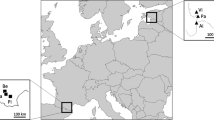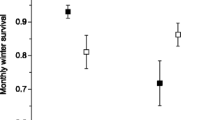Summary
We studied the characteristics of immigrants and the effects of immigration on reproductive activity and spacing behaviour in red squirrels living in high-quality woodlands. Male immigration peaked in spring, female immigration in autumn. There was no sex bias in dispersal distance of local recruits or in the proportion of male/female immigrants, but more subadults than adults immigrated on the study plots. Hence, hypotheses explaining sex-biased dispersal were irrelevant in explaining immigration patterns in our study populations. Immigrant females were not in breeding condition, nor had they produced a litter prior to immigration. Hence breeding dispersal did not occur. Red squirrels are promiscuous, and females defend intrasexual territories while males have overlapping home ranges with a dominance hierarchy (Wauters et al. 1990; Wauters and Dhondt 1992). Site fidelity is very important to reproductive success and most parents still have a high residual reproductive value after having produced a litter. Under such circumstances, the resident fitness hypothesis (RFH; Anderson 1989) predicts that parents can benefit by forcing emigration of offspring if the latter are likely to find nearby vacancies. The settlement pattern of successful immigrants, which had a higher probability of becoming established when they had high body mass and when they were settling in plots with reduced intrasexual competition, agreed with the RFH and with the proximate dispersal mechanism suggested by Gliwicz (1992), that dispersal tendency in both sexes depends on the degree of intrasexual competition under local conditions. The fact that close inbreeding was never observed could indicate that random immigration of both sexes, within the social environment of a partly territorial, relatively long-lived species, has evolved not only to reduce competition for resources between parents and offspring but also as an inbreeding avoidance mechanism.
Similar content being viewed by others
References
Anderson PK (1989) Rodent dispersal (Special Publication 9). American Society of Mammalogists
Armitage KB, Johns DW (1982) Kinship, reproductive strategies and social dynamics of yellow-bellied marmots. Behav Ecol Sociobiol 11:55–63
Arnold W (1990) The evolution of marmot sociality: I. Why disperse late? Behav Ecol Sociobiol 27:229–237
Bateson P (1983) Optimal outbreeding. In: Bateson P (ed) Mate choice. Cambridge University Press, Cambridge, pp 257–277
Boonstra R, Krebs CJ, Gaines MS, Johnson ML, Craine ITM (1987) Natal philopatry and breeding systems in voles (Microtus spp.). J Anim Ecol 56:655–673
Boutin S, Tooze Z, Price K (1993) Post-breeding dispersal by female red squirrels (Tamiasciurus hudsonicus): the effect of local vacancies. Behav Ecol 4: in press
Brandt CA (1992) Social factors in immigration and emigration. In: Stenseth NC, Lidicker WZ (eds) Animal dispersal. Small mammals as a model. Chapman and Hall, London, pp 96–141
Clutton-Brock TH, Albon SD, Guinness FE (1987) Interactions between population density and maternal characteristics affecting fecundity and juvenile survival in red deer. J Anim Ecol 56:857–871
Cockburn A (1992) Habitat heterogeneity and dispersal: environmental and genetic patchiness. In: Stenseth NC, Lidicker WZ (eds) Animal dispersal. Small mammals as a model.Chapman and Hall, London, pp 65–95
Cockburn A, Scott MP, Scotts DJ (1985) Inbreeding avoidance and sex-biased dispersal in Antechinus spp. (Marsupialia, Dasyuridae). Anim Behav 33:908–915
Dobson FS (1982) Competition for mates and predominant juvenile male dispersal in mammals. Anim Behav 30:1183–1192
Gaines MS, McClenaghan LR (1980) Dispersal in small mammals. Annu Rev Ecol Syst 11:163–196
Gliwicz J (1992) Patterns of dispersal in non-cyclic populations of small rodents. In: Stenseth NC, Lidicker WZ (eds) Animal dispersal. Small mammals as a model. Chapman and Hall, London, pp 147–159
Greenwood PJ (1980) Mating systems, philopatry and dispersal in birds and mammals. Anim Behav 28:1140–1162
Hamilton WD, May RM (1978) Dispersal in stable habitats. Nature 269:578–581
Harris MA, Murie JO (1984) Inheritance of nest sites in female Columbian ground squirrels. Behav Ecol Sociobiol 15:97–102
Holekamp KE (1984a) Dispersal in ground-dwelling sciurids. In: Murie JO, Michener GR (eds) The biology of ground-dwelling squirrels. University of Nebraska Press, London, pp 297–320
Holekamp KE (1984b) Natal dispersal in Belding's ground squirrels (Spermophilus beldingi). Behav Ecol Sociobiol 16:21–30
Holekamp KE, Sherman PW (1989) Why male ground squirrels disperse. Am Sci 77:232–239
Hoogland JL (1982) Prairie dogs avoid extreme inbreeding. Science 215:1639–1641
Jannett FJ (1980) Social dynamics of the montane vole, Microtus montanus, as a paradigm. Biologist 62:3–19
Kozakiewicz M (1976) Migratory tendencies in population of bank voles and description of migrants. Acta Theriot 21: 321–336
Krebs CJ, Wingate I, LeDuc J, Redfield JA, Taitt M, Hilborn R (1976) Microtus population biology: dispersal in fluctuating populations of M. townsendii. Can J Zool 54:79–95
Lidicker WZ (1975) The role of dispersal in the demography of small mammals. In: Petrusewicz K, Golley FB, Ryszkowski L (eds) Small mammals: productivity and dynamics of populations. Cambridge University Press, Cambridge, pp 103–128
Lidicker WZ (1985) Dispersal. In: Tamarin RH (ed) Biology of New World Microtus (Special Publication 8). American Society of Mammalogists, pp 420–454
Michener GR, Michener DR (1977) Population structure and dispersal in Richardson's ground squirrels. Ecology 58:359–368
Moore J, Ali R (1984) Are dispersal and inbreeding avoidance related? Anim Behav 32:94–112
Mosby HS (1969) The influence of hunting on the population of a woodlot gray squirrel population. J Wildl Manage 33:59–73
Murie JO (1973) Population characterisitics and phenology of a Franklin ground squirrel (Spermophilus franklinii) colony in Alberta, Canada. Am Midl Nat 90:334–340
Myers JH, Krebs CJ (1971) Genetic, behavioural, and reproductive attributes of dispersing field voles Microtus pennsylvanicus and Microtus ochrogaster. Ecol Monogr 41:53–78
Pasitschniak-Arts M, Bendell JF (1990) Behavioural differences between locally recruiting and dispersing gray squirrels, Sciurus carolinensis. Can J Zool 68:935–941
Pfeifer SLR (1982) Disappearance and dispersal of Spermophilus elegans juveniles in relation to behavior. Behav Ecol Sociobiol 10:237–243
Schwartz OA, Armitage KB (1980) Genetic variation in social mammals: the marmot model. Science 207:665–667
Sherman PW (1977) Nepotism and the evolution of alarm cells. Science 197:1246–1253
Slade NA, Balph DF (1974) Population ecology of Uinta ground squirrels. Ecology 55:989–1003
Stenseth NC (1978) Demographic strategies in fluctuating populations of small rodents. Oecologia 33:149–172
Stenseth NC, Lidicker WZ (1992) Animal dispersal. Small mammals as a model. Chapman and Hall, London
Thompson DC (1978) The social system of the grey squirrel. Behaviour 64:305–328
Wauters L, Dhondt AA (1989) Body weight, longevity and reproductive success in red squirrels (Sciurus vulgaris). J Anim Ecol 58:637–651
Wauters L, Dhondt AA (1990) Red squirrel (Sciurus vulgaris Linnaeus, 1758) population dynamics in different habitats. Z Saugetierkd 55:161–175
Wauters L, Dhondt AA (1992) Spacing behaviour of red squirrels, Sciurus vulgaris: variation between habitats and the sexes. Anim Behav 43:297–311
Wauters L, De Vos R, Dhondt AA (1990) Factors affecting male mating success in red squirrels (Sciurus vulgaris). Ethol Ecol Evol 2:195–204
Wauters L, Swinnen C, Dhondt AA (1992) Activity budget and foraging behaviour of red squirrels (Sciurus vulgaris) in coniferous and deciduous habitats. J Zool London 227:71–86
Wauters L, Bijnens L, Dhondt AA (1993) Body mass at weaning and local recruitment in the red squirrel. J Anim Ecol 62:280–286
Wiggett DR, Boag DA (1989) Intercolony natal dispersal in the Columbian ground squirrel. Can J Zool 67:42–50
Wolff JO (1992) Parents suppress reproduction and stimulate dispersal in opposite-sex juvenile white-footed mice. Nature 359:409–410
Author information
Authors and Affiliations
Additional information
Correspondence to: L. Wauters
Rights and permissions
About this article
Cite this article
Wauters, L., Dhondt, A.A. Immigration pattern and success in red squirrels. Behav Ecol Sociobiol 33, 159–167 (1993). https://doi.org/10.1007/BF00216596
Received:
Accepted:
Issue Date:
DOI: https://doi.org/10.1007/BF00216596




